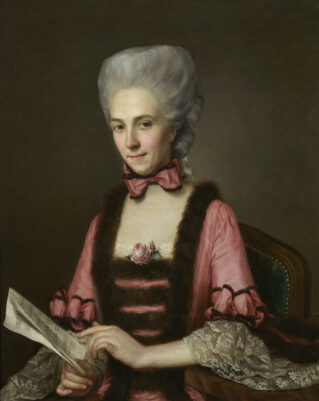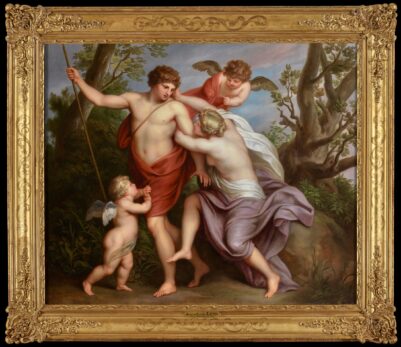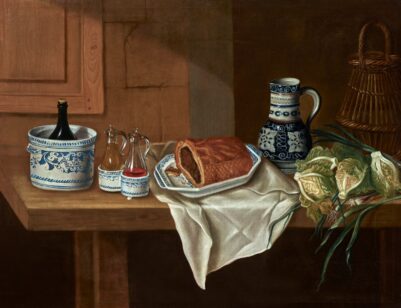
Nicolas-Bernard Lépicié
Portrait of a Lady
Provenance:
Private collection.
Sale, Sotheby’s Paris, 15 June 2022, lot. 187.
Catalogue Entry
Set against a monochromatic background, the charming figure of a young woman faces the viewer, as does her gaze. She is depicted in half-length on an oval-shaped canvas, a format that was much in vogue in mid-eighteenth-century French portraiture. The lady is elegantly dressed: she wears a white silk taffeta robe à la française, embellished on the square neck bodice by pink silky ribbon bows and an almost transparent veil encircling her neck. She wears her hair up, in a voluminous coiffure finished off with grey powder. On the lower left of the painting, a signature reveals the portrait’s author, as well as its year of execution: ‘Lépicié 1772.’ It is indeed the distinctive signature of French painter Nicolas-Bernard Lépicié.

Fig. 1. Nicolas Bernard-Lépicié, Le jeune dessinateur, oil on canvas, 55 x 46.5 cm., 1769/1772, Musée du Louvre, Paris.

Fig. 2. Nicolas Bernard-Lépicié, Portrait of a boy with a drawing book, possibly a pupil of the artist, oil on canvas, 41.5 x 32.3 cm., 1772, Mauritshuis, The Hague.

Fig. 3. Nicolas-Bernard Lépicié, Portrait of a young boy, half-length, wearing a grey coat and cap, oil on canvas, 45.4 x 36.7 cm., Private collection.
Born in Paris in 1735, Lépicié began his career studying engraving with his father, François-Bernard (1698-1755), who held the post of graveur du roi (engraver to the king) and perpetual secretary of the Académie Royale. Poor eyesight, however, soon forced him to abandon engraving and turn completely “to painting, under the vigilance of Mr Carle Vanloo (Charles-André van Loo, 1705-1765)”.1 As a painter, Lépicié often placed high in the annual Académie competitions and, since 1765, exhibited regularly at the Salon. He was admitted to the Académie as an associate member in 1764 and as a full member five years later, being nominated professor in 1779. Lépicié entered the Académie as a history painter, yet his most successful works were genre paintings and portraits, which make up over three-quarters of his oeuvre. By the time of his premature death at the age of forty-nine, Lépicié was living in the Louvre, where his atelier was frequented by numerous pupils, including Jean-Baptiste Regnault (1754-1829), Jean-Charles Nicaise Perrin (1754-1829) and Carle Vernet (1758-1836), among others.2

Fig. 4. Nicolas Bernard-Lépicié, Le Lever de Fanchon, oil on canvas, 74 x 93 cm., 1773, Musée De L’hôtel Sandelin, Saint-Omer, France.
Although Lépicié originally dreamed to be a history painter, his contemporaries often criticised his historical and mythological compositions, while praising his talent as a genre and portrait painter.3 “He (Lépicié) was a painter of nature and everything he did was imbued with the truth,” wrote an anonymous critic about Lépicié’s art during the Salon of 1785.4 As per another critic, “His small paintings are of an astonishing truth; nature is his master.”5 Such statements seem to find a visual proof in the present portrait, which Lépicié painted with striking naturalism. The artist focused his attention on the sitter’s expression, her tender yet melancholic smile and gaze, and on the reddening of her cheeks. The neutral background – a distinctive feature of Lépicié portraiture during the 1770s (e.g. Fig. 1-3) – enhances the overall sweetness and spontaneity of the figure. Such an intimate tone and calm naturalism show the influence of Jean-Siméon Chardin (1699-1779), a friend of Lépicié’s father, whose work the artist had closely studied from life and through the prints that his mother used to engrave.6

Fig. 5. Nicolas Bernard-Lépicié, Portrait of a young lady sewing or Portrait of Madame Lagrenée, c. 1771, oil on canvas, Private collection.

Fig. 6. Nicolas Bernard-Lépicié, Portrait d’Emile Vernet, future Madame Chalgrin, oil on canvas, 58.8 x 50.5 cm., 1769, Musée des Beaux-Arts de la ville de Paris, Paris.
As attested by Chardin’s still-lives and portraits, the demand for verisimilitude and naturalness in French genre painting and portraiture grew in France over the course of the eighteenth century. That was indeed a moment when French artists, including Lépicié himself, took increasing inspiration from Dutch seventeenth-century art.7 By looking at painters such as David Teniers the Younger (1610-1690), Lépicié developed his own touches of realism, his thickly applied yet delicate palette and his muted, silvery colours, which are those described by one of the critics of the 1773 Salon and which characterise the present portrait. The balanced interplay of silvery whites, greys and warmer pinks, rendered with vibrant brushstrokes, reveals Lépicié’s skills as a colourist, alongside his awareness of a new style favouring natural effects over sumptuousness. His exquisite ability to render the different textures of materials and surfaces – here exemplified by the transparencies of the organza veil, the palpable quality of the decorative ribbons and the woman’s complexion – is the same found in Lépicié’s genre scenes of the 1770s,8 including his famous Le Lever de Fanchon (1773, Musée De L’hôtel Sandelin, Saint-Omer, Fig. 4).

Fig. 7. Nicolas Bernard-Lépicié, Portrait of the Leroy Family, oil on canvas, 1766, The Pushkin Museum, Moscow.

Fig. 8. Nicolas Bernard-Lépicié, Portrait de Quatremère et de sa famille, oil on canvas, 53 x 62 cm., 1780, Musée du Louvre, Paris.
In the majority of his portraits, Lépicié merges portrait and genre painting to suggest the sitter’s profession or status, as exemplified by other female portraits by his hand, including the Portrait of a young lady sewing or Portrait of Madame Lagrenée (ca. 1771, Private collection, Fig. 5). In the present canvas, Lépicié suggests the woman’s high social status through her outfit alone. Indeed, she wears a robe à la française, a garment that, by the 1770s, had become the second most elegant outfit in France after court dress. The woman’s hairstyle can be identified as a pouf, a voluminous coiffure constructed in height using pads and cushions, eventually powdered with grey or white powder, which became the most fashionable female hairstyle in France after Marie Antoinette wore it in June 1775 at the coronation of her husband Louis XVI.
Although Lépicié usually painted the people, the little bourgeoisie and his own pupils, portraits of the upper class by his hand are also documented. In particular, the present work can be compared to the Portrait of Emile Vernet (1769, Musée des Beaux-Arts de la ville de Paris, Paris, Fig. 6), where the woman who would later marry the famous architect Jean Chalgrin is represented with delicate naturalism at nine years old. Although the identity of the present sitter remains a mystery, one could imagine her to belong to one of the aristocratic families that were Lépicié’s neighbours in the Louvre area – which, apparently, he never left – and that he immortalised in works such as the Portrait of the Leroy Family (1766, Pushkin Museum, Fig. 7) and the Portrait de Quatremère et de sa famille (Musée du Louvre, Fig. 8).
1 Philippe Gaston-Dreyfull and Florence Ingersoll-Smouse, Catalogue raisonné de l'œuvre peint et dessiné de Nicolas-Bernard Lépicié, 1735-1784, (Paris: Bulletin de la Société de l'Histoire de l'Art Français, 1923), p. 13: “entièrement à la peinture, sous les yeux de M. Carle Vanloo.” 2 For a detailed study on Nicolas-Berbard Lépicié, see Gaston-Dreyfull and Ingersoll-Smouse, Catalogue Raisonné, pp. 11-17. 3 Denis Diderot, for example, criticised the lack of enthusiasm and historical truth in Lépicié’s history paintings, while praising him as a genre painter. See, Gaston-Dreyfull and Ingersoll-Smouse, Catalogue raisonné, p. 19. 4 Ibid., p. 20. 5 Ibid., p. 20. 6 Lépicié’s mother, Renée-Élisabeth Marlié (1714-1773), was a French engraver, who signed various prints with her name, including engravings of Jean-Siméon Chardin’s Bénédicité and La Mère laborieuse, and of works by David Teniers the Younger. For biographical information on Renée-Élisabeth Marlié, see Roger Portalis and Henri Beraldi, Les Graveurs du Dix-huitième Siècle, Vol. I, (Paris: Morgand et Fatout, 1880–82), p. 662. 7 Pierre Rosenberg, The Age of Louis XV, French Painting 1740-1774, 1975-1976, (The Toledo Museum of Art, October 26-December 7. The Art Institute of Chicago, January 10-February 22. The National Gallery of Canada, March 21-May 2), pp. 54-55. 8 For a detailed study on Lépicié as a genre painter, see Florence Ingersoll-Smouse, “Nicolas-Bernard Lépicié. Peintre de Genre,” in La Revue de l’Art Ancien et Moderne, Tome XLVI, no. 257, June 1924, pp. 122-130.
Condition:
The painting is in good condition. It is unlined, and the support is sound and stable. The paint layer is in good condition, and it does not show any major losses or uplifts. A network of light cracks is visible across the canvas. The UV light reading does not seem to reveal any retouches.
The painting was recently restored, cleaned and revarnished. Its original stretcher was consolidated and reinforced. Chromatic reintegration was made.



